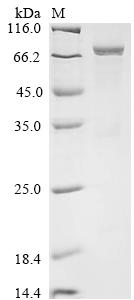Recombinant Human Eosinophil Peroxidase (EPX) comes from an E. coli expression system and represents the full length of the mature protein, spanning amino acids 140 to 715. The protein carries an N-terminal 6xHis tag, which helps with purification and detection. SDS-PAGE analysis shows the product achieves greater than 85% purity. This recombinant protein is designed for research use only, though it appears to offer reliable consistency for experimental work.
Eosinophil peroxidase (EPX) is a key enzyme that's mainly found in eosinophils—a specific type of white blood cell that participates in immune responses. EPX seems to play an important role in creating reactive oxygen species, which likely contributes to both microbial killing and inflammatory processes. Researchers are particularly interested in this enzyme because of its involvement in inflammatory pathways and its potential as a biomarker for eosinophil-related disorders.
Potential Applications
Note: The applications listed below are based on what we know about this protein's biological functions, published research, and experience from experts in the field. However, we haven't fully tested all of these applications ourselves yet. We'd recommend running some preliminary tests first to make sure they work for your specific research goals.
Based on the provided information, the recombinant Human Eosinophil peroxidase (EPX) is expressed in E. coli, a prokaryotic system that is generally unsuitable for producing complex eukaryotic proteins like EPX, which requires precise folding, disulfide bond formation, and glycosylation for full activity. The protein is full-length mature (140-715aa) with an N-terminal 6xHis tag, and purity is >85% by SDS-PAGE, indicating low contamination but not confirming correct folding. Since activity is unverified, the protein cannot be assumed to be correctly folded or bioactive. E. coli often fails to properly fold proteins with complex post-translational modifications, so experimental validation (e.g., enzymatic activity assays) is essential to confirm bioactivity.
1. Antibody Development and Validation Studies
This recombinant EPX protein may work well as an immunogen for creating polyclonal or monoclonal antibodies against human eosinophil peroxidase. The N-terminal 6xHis tag makes purification and immobilization straightforward for antibody screening assays. Researchers can also use the protein as a positive control in Western blot, ELISA, and immunohistochemistry experiments to check antibody specificity. With its greater than 85% purity, the protein appears suitable for immunization protocols and follow-up antibody characterization studies. However, if the protein is misfolded, antibodies may not recognize conformational epitopes of native EPX, so validation against endogenous EPX from human samples is recommended.
2. Protein-Protein Interaction Studies
The 6xHis tag makes pull-down assays technically feasible for identifying potential EPX binding partners in cellular lysates or purified protein libraries. Scientists can attach the recombinant protein to nickel-affinity resins to capture interacting proteins, then analyze them using mass spectrometry or Western blotting. However, if EPX is misfolded, it may not interact physiologically with true binding partners, leading to non-specific or false interactions. This application should only be pursued after confirming protein folding and activity through functional assays.
3. Biochemical Characterization and Stability Studies
The purified recombinant EPX works for detailed biochemical analysis, including protein folding studies, thermal stability assessments, and pH tolerance experiments. Researchers can systematically test the protein's behavior under different buffer conditions, salt concentrations, and storage temperatures using techniques like dynamic light scattering, circular dichroism spectroscopy, and analytical ultracentrifugation. These studies may provide fundamental insights into EPX protein properties and help determine optimal handling conditions for research applications. This application is appropriate even if the protein is misfolded, as it directly characterizes the recombinant product.
4. ELISA Development and Standardization
This recombinant EPX protein appears well-suited as a standard and positive control for developing quantitative ELISA assays to measure EPX levels in biological samples. The consistent quality and known concentration of the recombinant protein allow for the construction of reliable standard curves for EPX quantification. The 6xHis tag permits oriented attachment to ELISA plates, which could improve assay sensitivity and reproducibility compared to random protein orientation. However, if the protein is misfolded, conformational epitopes may be altered, leading to inaccurate quantification. Validation against native EPX is essential for reliable results.
Final Recommendation & Action Plan
Given the high risk of misfolding due to E. coli expression, it is crucial to first validate the protein's conformation and bioactivity before most applications. Recommend performing biophysical characterization (e.g., size-exclusion chromatography for oligomeric state, circular dichroism for secondary structure) and functional enzymatic assays (e.g., peroxidase activity with substrates like ABTS or hydrogen peroxide) to confirm folding and activity. If validated, the protein can be used for interaction studies and ELISA development; if not, focus on antibody development and biochemical characterization. Always include controls such as native EPX from eukaryotic sources for comparison. For reliable functional studies, consider using an alternative expression system (e.g., mammalian cells) that supports proper folding and modifications.






